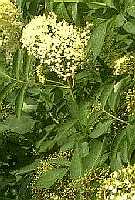View crop
View crop Data sheet EcoPortSambucus canadensis
 |
|
| Notes |
|---|
| DESCRIPTION: It is a bushy, multi-stemmed, wide-spreading shrub with deciduous compound leaves. It gets 3-4.5 m tall with a similar spread, and its brittle branches are pithy and soft. It often forms dense thickets, a result of suckering from the roots. The leaves are opposite, pinnately compound (feather-like), and up to a 30 cm long. There are 5, 7 or 9 saw-toothed leaflets, each about 5-15 cm long. The star-shaped white flowers are tiny, but arranged in showy sprays up to 25 cm across. The edible fruits are shiny blue-black berry-like drupes with 3-5 stoney seeds. GROWING PERIOD: Perennial. USE: The bush can be used as an ornamental, it is best in the naturalized or wildlife garden, in wet areas of the landscape, and along roads. The flowers are used to make elderflower water which is used in perfumes and confectioneries. Raw elderberries have an unpleasant taste and contain small amounts of poisonous alkaloids. Cooking destroys the alkaloids and improves the taste. (The dried berries are said to be good to eat raw, however.) Cooked elderberries are made into pies, jellies, and of course, elderberry wine. The flowers are also edible, and used in jams, jellies and are the basis of elderflower fritters. COMMON NAMES: American elder, Eastern elderberry, American elderberry FURTHER INF: It is native to eastern North America, from Nova Scotia to Florida, and west to Minnesota and Texas, where it occurs in rich soils along riverbanks and forest edges. | Sources |
| SOURCES Hackett C 1982 pp 86 [FER, PHO, DEP, PH, TEXT, TEMP] Duke J 1975 pp 26 [PH, RAIN, TEMP] Roecklein J 1987 pp 213 [USE] |